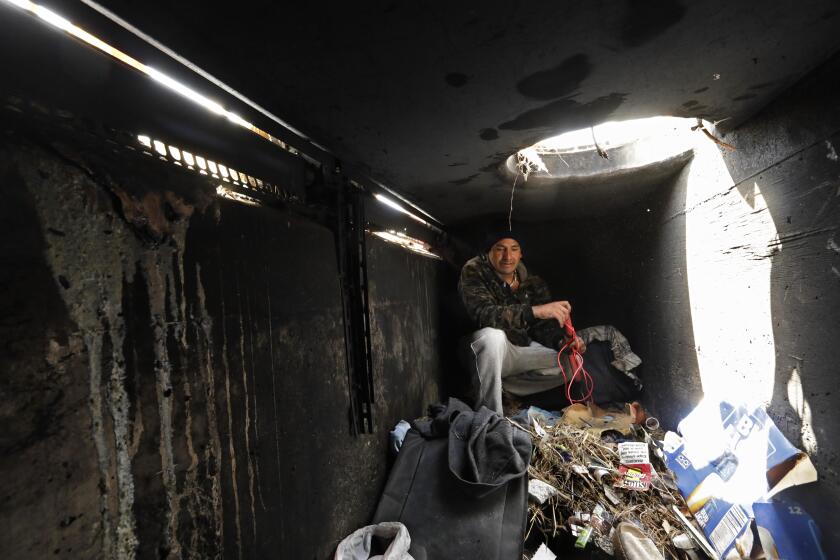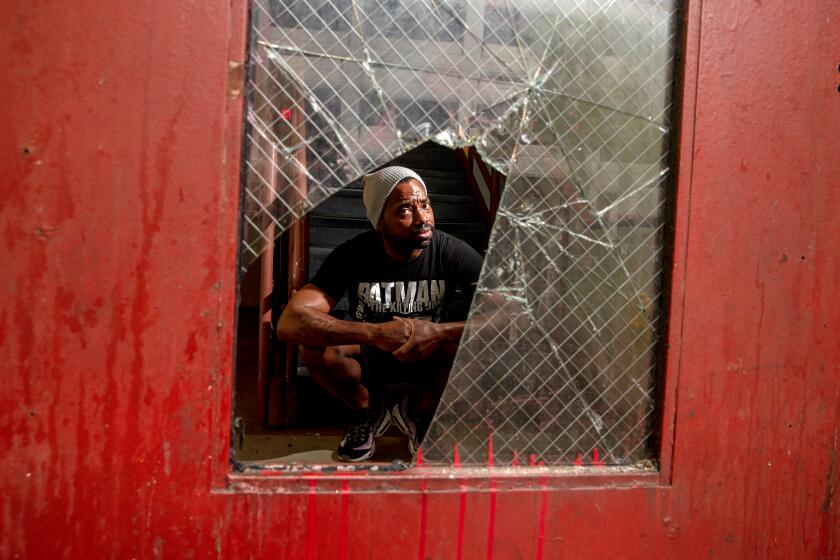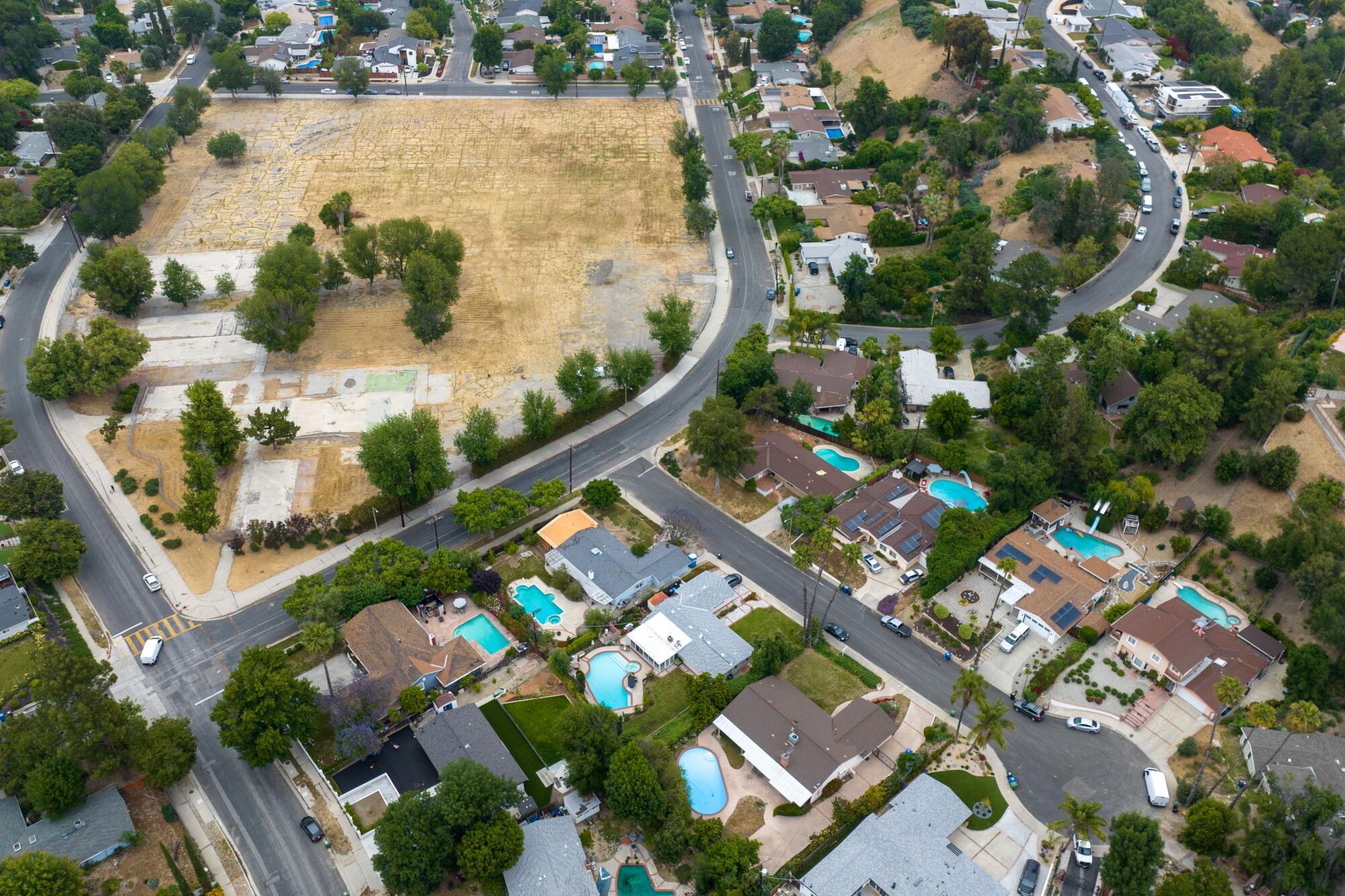
- Share via
On Google Earth it looks like a stunning opportunity: six acres of vacant land surrounded by single-family homes in a West Valley neighborhood.
After being abandoned to shoulder-high weeds for nearly a decade, the former elementary school site in Woodland Hills is now a target for development.
But it’s not being scoped out for million-dollar homes like those around it. Instead, a group of prominent civic leaders has identified the parcel as a prime location for shelter or housing for homeless people.
It’s on a list commissioned by the Committee for Greater L.A. to prod City Hall to use surplus government land for homeless housing.
“If you talked to people in the city ... they will argue that it is a myth, that all the land that is available is really not appropriate for this use,” said Miguel Santana, chairman of the committee, which is made up of leaders in philanthropy, business and government.
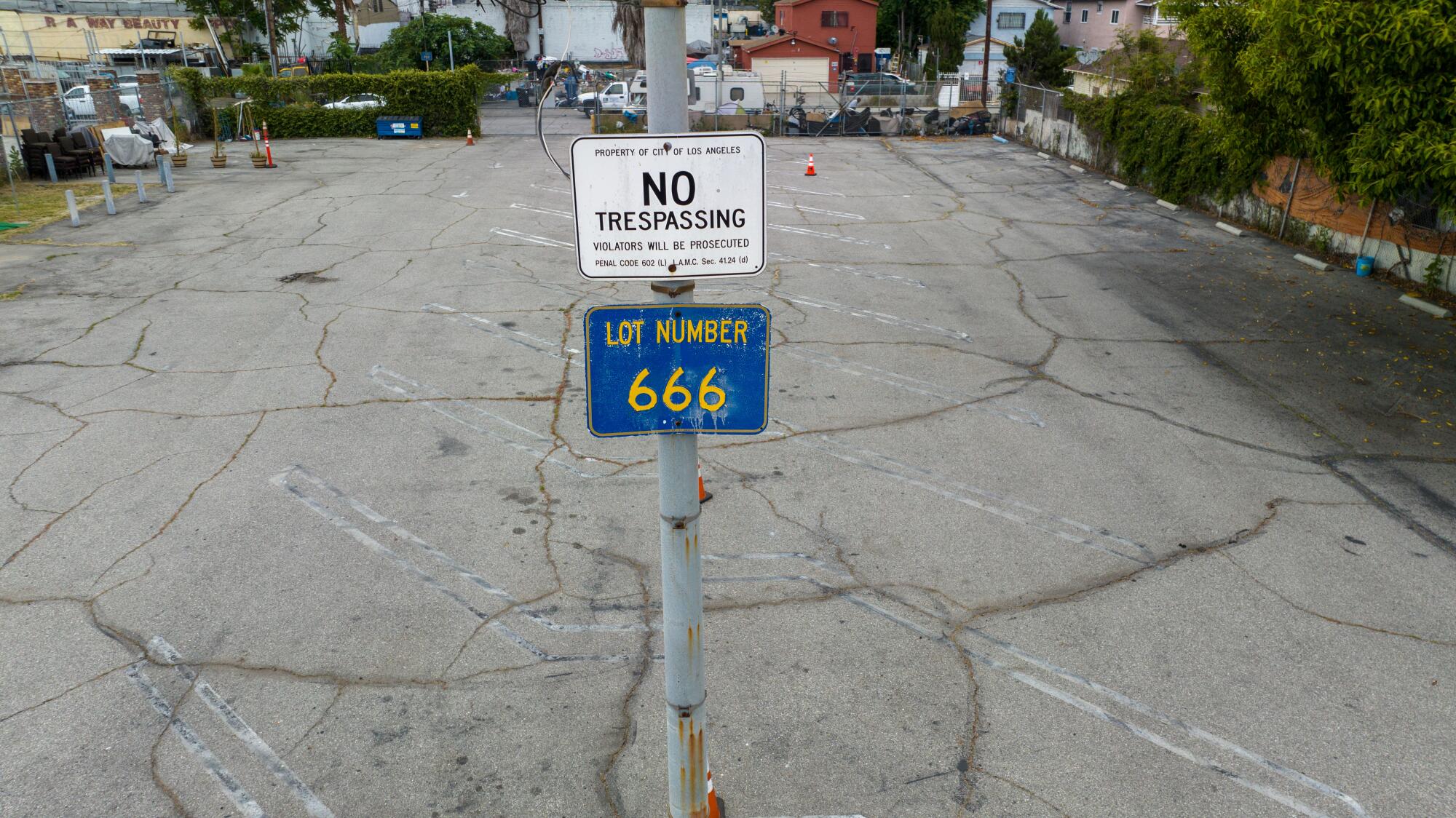
In releasing a database of 126 proposed sites online, the committee sought to keep up pressure on Mayor Karen Bass to follow through on her campaign pledge to build 1,000 beds on public land in her first year in office.
The study‘s authors said they identified more than enough usable parcels to support 1,000 beds of shelter and permanent housing, and proposed a timeline to produce the housing within six months.
Bass has acknowledged the committee’s work but said she has her own list of properties and her own timeline. And the timeline is longer.
In an open letter, Bass, whose third executive order required the city administrative officer to compile an inventory of city-owned land suitable for housing, said her staff is poring over a list of more than 3,300 parcels and has had preliminary discussions with City Council members to gauge their reaction to specific sites.
She said they have identified sites to accommodate 500 interim housing beds and have submitted them to the state to be part of Gov. Gavin Newsom’s emergency small-homes program. If approved, she said, they could be built by July 2024.
But Bass said she wants to rethink the city’s approach to permanent housing on its lands to develop a “bigger and bolder” program. She set a goal of January 2025 to come up with standards for identifying suitable land, community engagement strategies, provisions for infrastructure investments, new financing methods and innovative approaches to construction.

“My focus over the remainder of my first term in office will be to make the disposition and development of City owned land faster, cheaper, and more streamlined, and to innovate in the financing and delivery of affordable housing without reliance on traditional subsidy methods,” Bass wrote.
While working primarily from the city’s own list, Bass said, she will use the committee’s study to advance her goal of incorporating surplus land owned by regional and state agencies.
The study, conducted by the nonprofit Center for Pacific Urbanism, analyzed variables including slope, zoning and proximity to utilities to winnow down 65,000 parcels owned by city, county, state, federal and other agencies such as Metro and the Los Angeles Unified School District.
Dario Rodman-Alvarez, an architect whose firm Pacific Urbanism founded the nonprofit, said he and his staff then reviewed each of the nearly 2,900 survivors to verify that it would be suitable for a model development consisting of 36 units interspersed with community gardens.
From those, they hand-picked 121 to give officials “enough options to make decisions but not be overwhelmed by the sheer number of options.”
A Times spot check of sites on that list, however, showed how frequently political impediments can confound even the best analysis.
The city of Los Angeles bought a 10-acre property to bring jobs to Watts after the 1992 riots. Proposed projects came and went, leaving weeds, trash and shanties.
The former Oso Elementary property in the West Valley, for example, has long been a point of community contention. Residents of the area, called Carlton Terrace, said that they want something done with the eyesore — most suggested a park — but that homeless housing would be unacceptable.
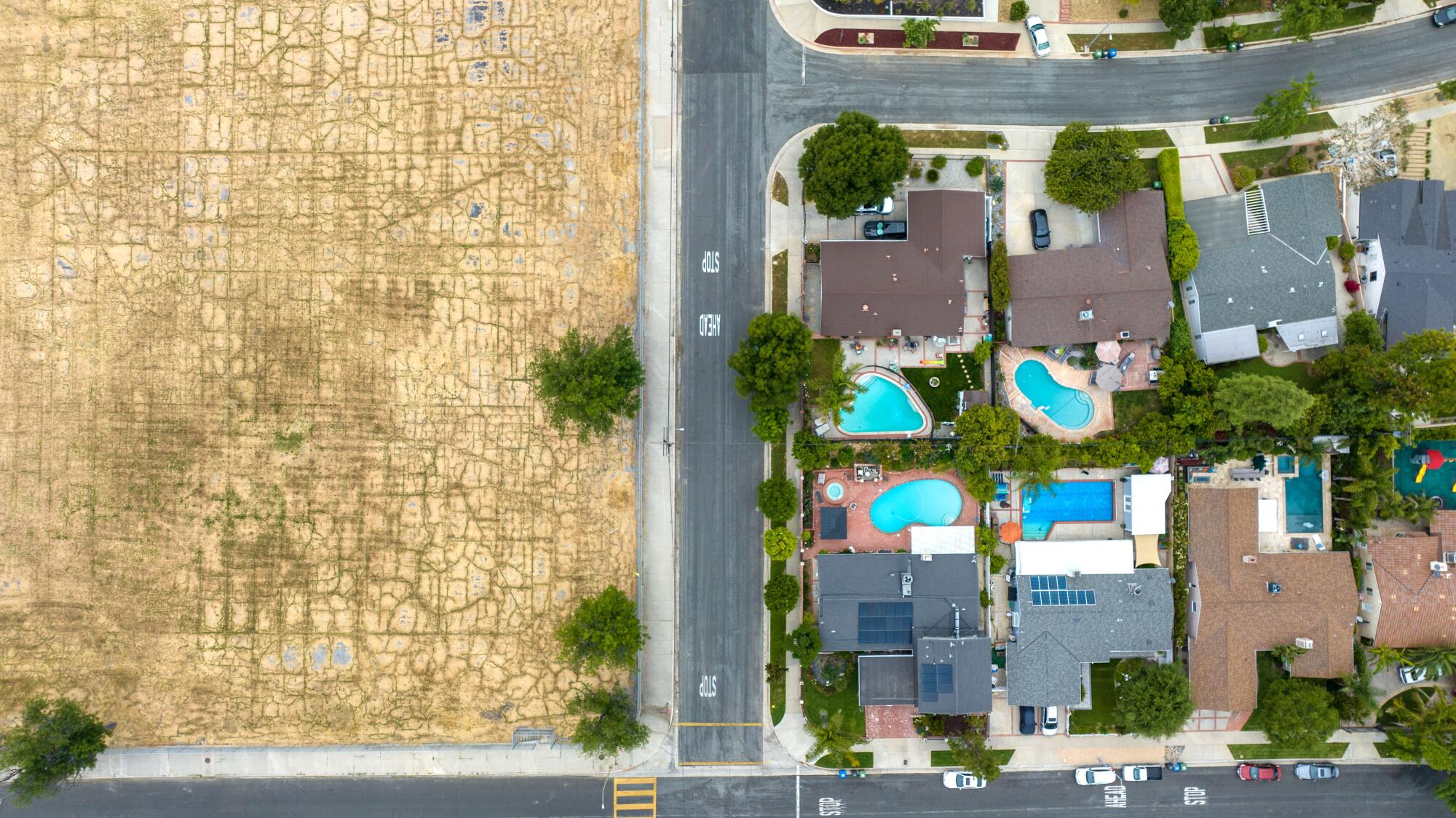
“It’s never going to happen,” said Darryl Lutz, a 20-year resident across from one corner of the vacant land. “The homeowners here are heavily involved in local government.”
Joyce Norman, an emergency room physician, said she would not oppose a shelter except that she doubted it would come with adequate services, especially transportation. The nearest shopping is downhill a half-mile away.
“If I were a homeless person, I would want to live near a street with stores,” she said.
Not to mention, the Los Angeles Unified School District may have its own plans for the property. It was included in a 2020 proposal to evaluate 10 properties for development as housing for district employees.
A district spokesperson would not give an update on that proposal, instead providing a statement that the district “is currently evaluating our underutilized properties to help develop a plan that most effectively addresses the needs of our district and the communities that we serve.”
To sidestep possible roadblocks caused by differing governmental agendas, the committee study identified 46 sites, all owned by the city, as highest priority.
But those were not free of roadblocks either.
One — 2.1 acres of vacant land in Sylmar surrounded by a neighborhood of single-family homes, condos and apartments — is already slated for affordable housing, but the first developer chosen by the city backed out, and the Los Angeles Housing Department is again preparing a request for proposals.
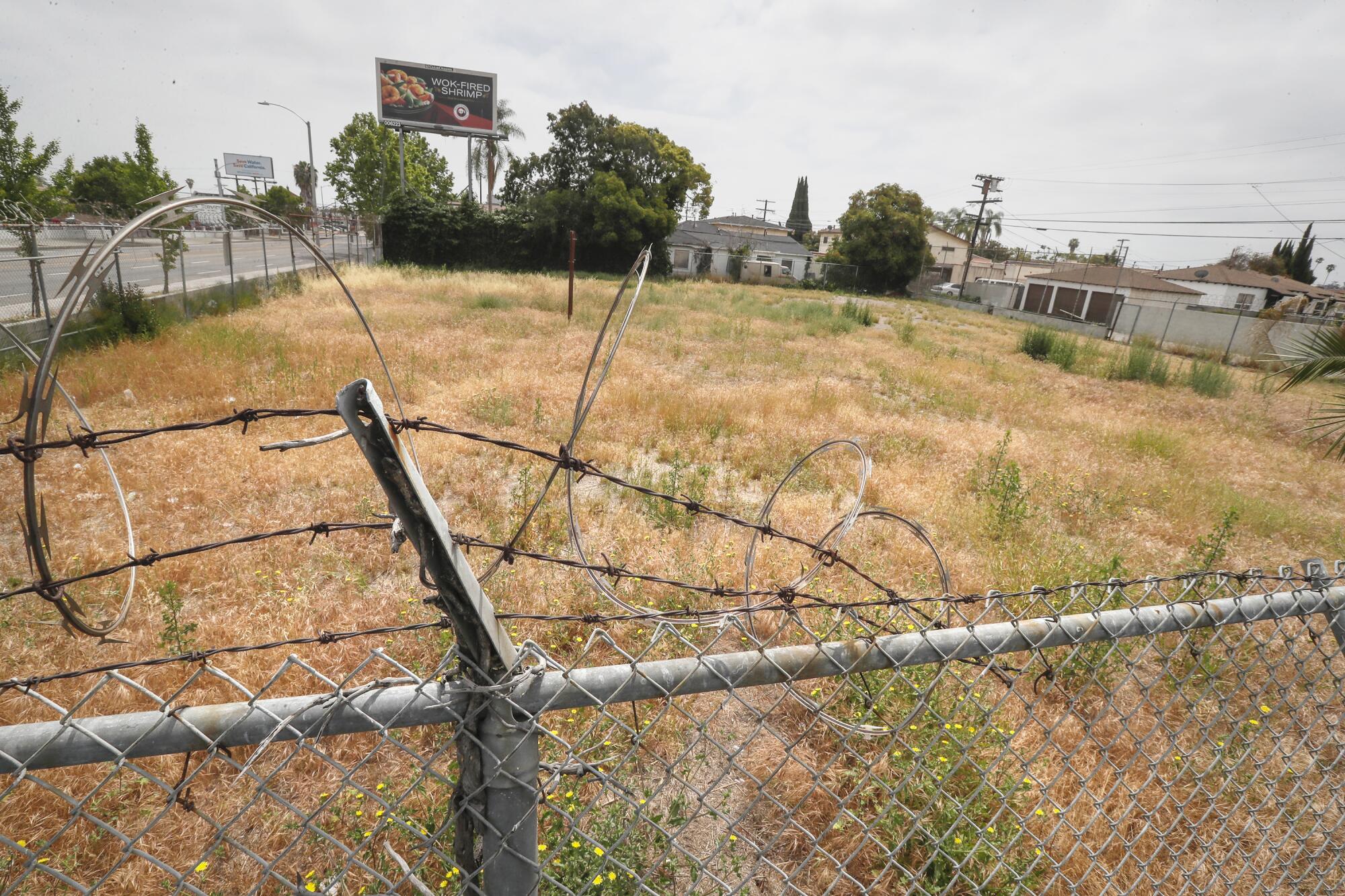
“We have been working urgently to ensure this property is used for housing and are exploring options for the best site use with the least amount of downtime possible,” Councilwoman Monica Rodriguez said.
That’s the bureaucratic maze that Bass must cut through.
Her program will not only identify sites but also hand them to developers ready to go, said Jenna Hornstock, Bass’ housing deputy.
“So rather than put out these sites and say, ‘Now go out and entitle them and compete for money,’ it’s, ‘Here’s the site. We either have entitlement or a path to entitlement and here is a financing plan that we will commit to,’ ” Hornstock said.
The idea of using surplus government land to speed up and lower the cost of homeless housing goes back to 2016 when committee Chairman Santana, who was then the city administrative officer, included it in an ambitious plan to address homelessness.
Santana’s office examined more than 500 city-owned properties that found 129 sites potentially large enough and in suitable zones for homeless housing. All but 10 were city-owned parking lots.
Few of them worked out.
The Skid Row Housing Trust was a model for nonprofits housing homeless people in Los Angeles. Behind the scenes, it was imploding — leaving tenants in squalor.
When then-City Controller Ron Galperin reviewed the topic in a 2022 report critical of the city’s “fragmented” management of surplus land, he found that 11 of the city’s bridge home shelters and 16 projects in development under the city’s $1.2-billion HHH housing bond were on city-owned land.
Bass, in her letter, said 14 more are in design or negotiation, but concurred that it was not enough.
Galperin highlighted 26 city-owned properties that he considered suitable for shelter projects, either bridge housing, safe parking, safe sleeping villages or tiny home villages. But like the earlier study, it was heavily weighted with parking lots.
Public parking lots, which also make up slightly more than half of the committee’s priority list, are often problematic because they serve local businesses and generate revenue for the city.
One parking lot on the list is in the business core of Leimert Park. Converting it to housing would only exacerbate a lack of adequate parking in the “Mecca of Black culture in Los Angeles,” a spokesman for Councilwoman Heather Hutt said in an email reply to The Times.
“Councilwoman Hutt cannot support homeless housing on these parking lots because the community will never support it,” the statement said. “The residents have demonstrated a strong commitment to preserving the authenticity and character of Leimert Park, and the parking lots serve that authenticity and character.”
At the other extreme, a city parking lot on 87th Street a block east of Broadway has no current value to the depressed business district where several vacant lots and abandoned buildings are owned by an investor who has held them since the 1990s and rebuffed all suitors.
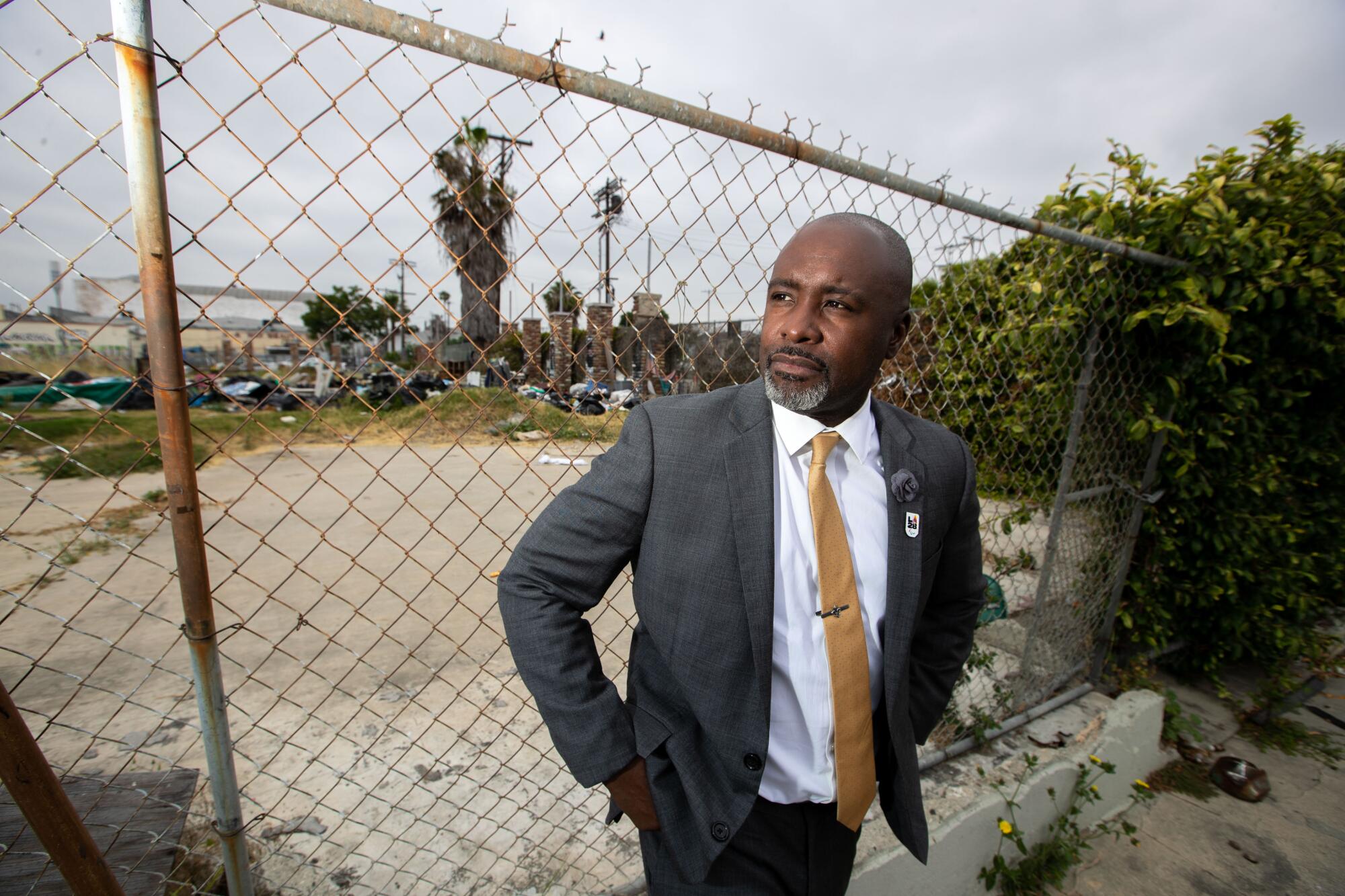
Councilmember Marqueece Harris-Dawson, who said he rejected all the other sites the mayor suggested, would like to put housing on that lot, and another one west of Broadway, but only if the city would seize the adjacent privately owned properties to provide space for more units.
After years of unsuccessful overtures to the property owners, Harris-Dawson said he is ready to reconsider the city’s long-standing reluctance to use eminent domain.
“You could make a village there,” he said.
With a district dotted with privately owned vacant lots, Harris-Dawson said he thinks there are far more appropriate options than the few government parcels.
The Pacific Urbanism study acknowledged the potential of privately held land and included five examples, including the parking lot at Hebrew Union College and the expanse of parking around Dodger Stadium.
Some organizations, such as churches, may be open to using their land for purposes that align with their mission, it said, but made no mention of eminent domain.
“For every public lot that’s vacant, I can take you to two privately held lots that are as good or better for housing,” Harris-Dawson said. “We literally have people living in the streets. Maybe after 35 years we intervene and help you find a different investment to make.”
By publishing its study, the Committee for Greater L.A. intends to force public officials to be more transparent, said committee member Sarah Dusseault, a former commissioner of the Los Angeles Homeless Services Authority.
“If you want to keep this surface parking lot as a surface parking lot because it earns $20,000 a year, God bless,” Dusseault said.
“But you should be transparent about that as a policy choice instead of the policy choices being in the dark.”
More to Read
Sign up for Essential California
The most important California stories and recommendations in your inbox every morning.
You may occasionally receive promotional content from the Los Angeles Times.
